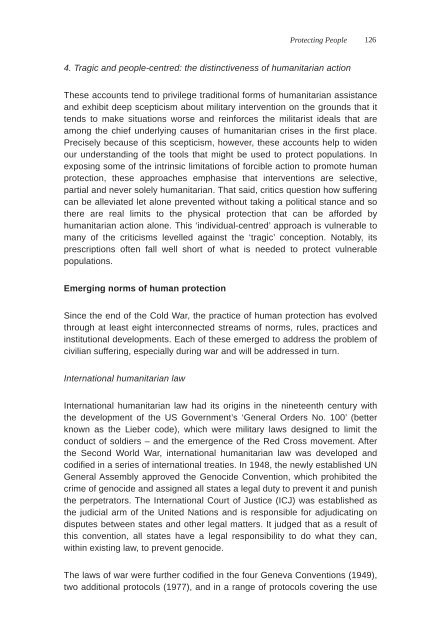International Relations
International-Relations-E-IR
International-Relations-E-IR
Create successful ePaper yourself
Turn your PDF publications into a flip-book with our unique Google optimized e-Paper software.
Protecting People<br />
126<br />
4. Tragic and people-centred: the distinctiveness of humanitarian action<br />
These accounts tend to privilege traditional forms of humanitarian assistance<br />
and exhibit deep scepticism about military intervention on the grounds that it<br />
tends to make situations worse and reinforces the militarist ideals that are<br />
among the chief underlying causes of humanitarian crises in the first place.<br />
Precisely because of this scepticism, however, these accounts help to widen<br />
our understanding of the tools that might be used to protect populations. In<br />
exposing some of the intrinsic limitations of forcible action to promote human<br />
protection, these approaches emphasise that interventions are selective,<br />
partial and never solely humanitarian. That said, critics question how suffering<br />
can be alleviated let alone prevented without taking a political stance and so<br />
there are real limits to the physical protection that can be afforded by<br />
humanitarian action alone. This ‘individual-centred’ approach is vulnerable to<br />
many of the criticisms levelled against the ‘tragic’ conception. Notably, its<br />
prescriptions often fall well short of what is needed to protect vulnerable<br />
populations.<br />
Emerging norms of human protection<br />
Since the end of the Cold War, the practice of human protection has evolved<br />
through at least eight interconnected streams of norms, rules, practices and<br />
institutional developments. Each of these emerged to address the problem of<br />
civilian suffering, especially during war and will be addressed in turn.<br />
<strong>International</strong> humanitarian law<br />
<strong>International</strong> humanitarian law had its origins in the nineteenth century with<br />
the development of the US Government’s ‘General Orders No. 100’ (better<br />
known as the Lieber code), which were military laws designed to limit the<br />
conduct of soldiers – and the emergence of the Red Cross movement. After<br />
the Second World War, international humanitarian law was developed and<br />
codified in a series of international treaties. In 1948, the newly established UN<br />
General Assembly approved the Genocide Convention, which prohibited the<br />
crime of genocide and assigned all states a legal duty to prevent it and punish<br />
the perpetrators. The <strong>International</strong> Court of Justice (ICJ) was established as<br />
the judicial arm of the United Nations and is responsible for adjudicating on<br />
disputes between states and other legal matters. It judged that as a result of<br />
this convention, all states have a legal responsibility to do what they can,<br />
within existing law, to prevent genocide.<br />
The laws of war were further codified in the four Geneva Conventions (1949),<br />
two additional protocols (1977), and in a range of protocols covering the use


